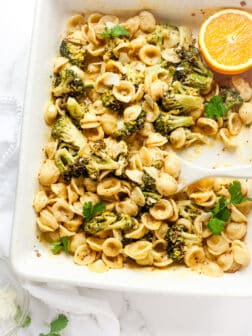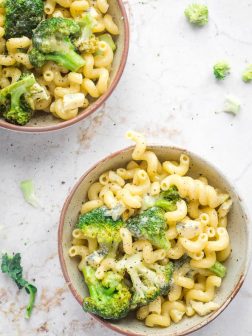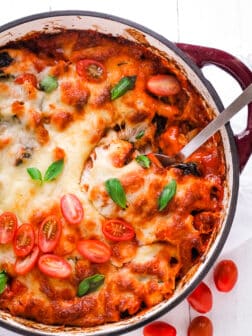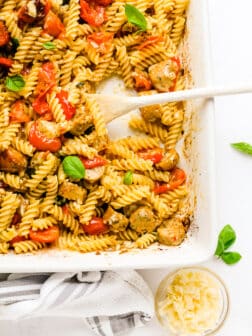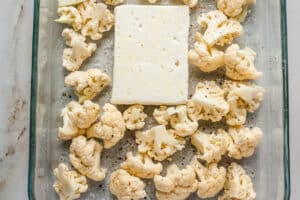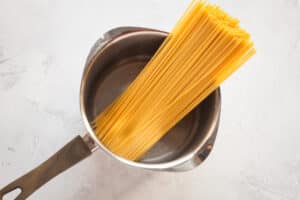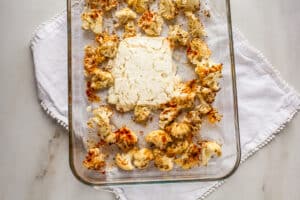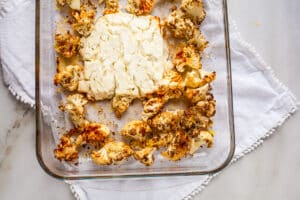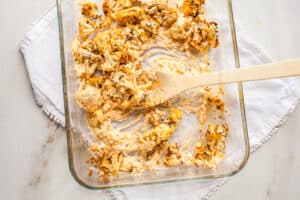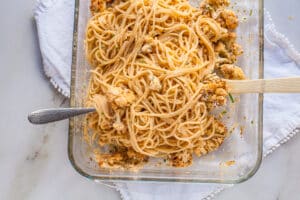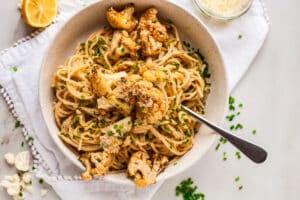This baked cauliflower feta spaghetti is simple to prepare and absolutely packed with the flavors of garlic and lemon! It’s so easy to make: the cauliflower roasts alongside a block of feta in a pan, then it all gets tossed together with the pasta to make a tasty feta sauce.
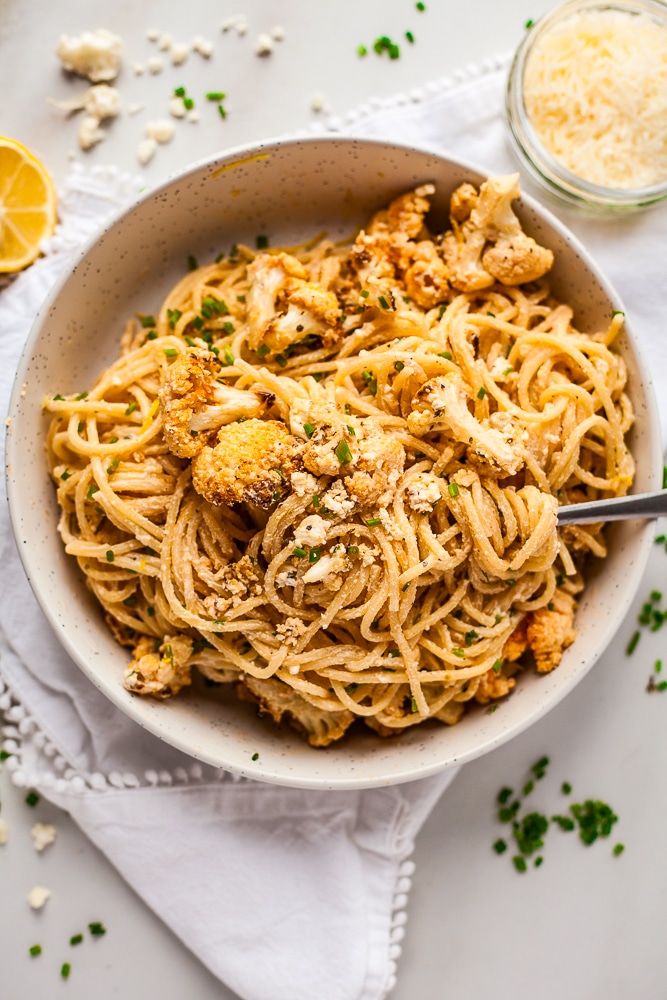
Let’s make a meal out of roasted cauliflower
Don’t be fooled by how beige this plate it – despite the limited color palette, there is sooo much flavor hiding away in this bowl. Bright, fresh, herby flavors just waiting to pop.
If you already love roasted cauliflower, great! You probably don’t need convincing that it’s going to be delicious tossed with lots of herbs, spaghetti and a melty lemony feta sauce. If you haven’t tried it yet, I am confident it will change your relationship with cauliflower forevermore, because nutty spiced charred cauliflower is not like the other cauliflowers (it’s, ahem, the cool cauliflower).
This pasta is a breeze to make and super flexible to fit in with the contents of your fridge and your spice collection. Let’s dive in…
This works a lot like that viral feta pasta…
This is a really simple process and works a lot like the viral feta and tomato pasta that did the rounds on social media. We roast the cauliflower alongside the block of feta, and then it all gets mixed together at the end.
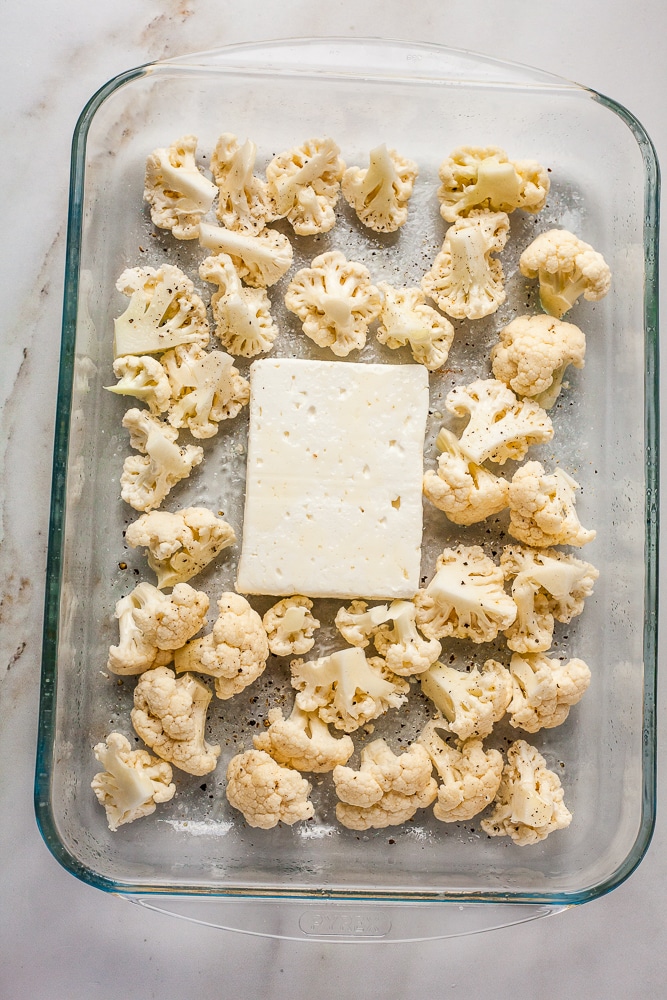
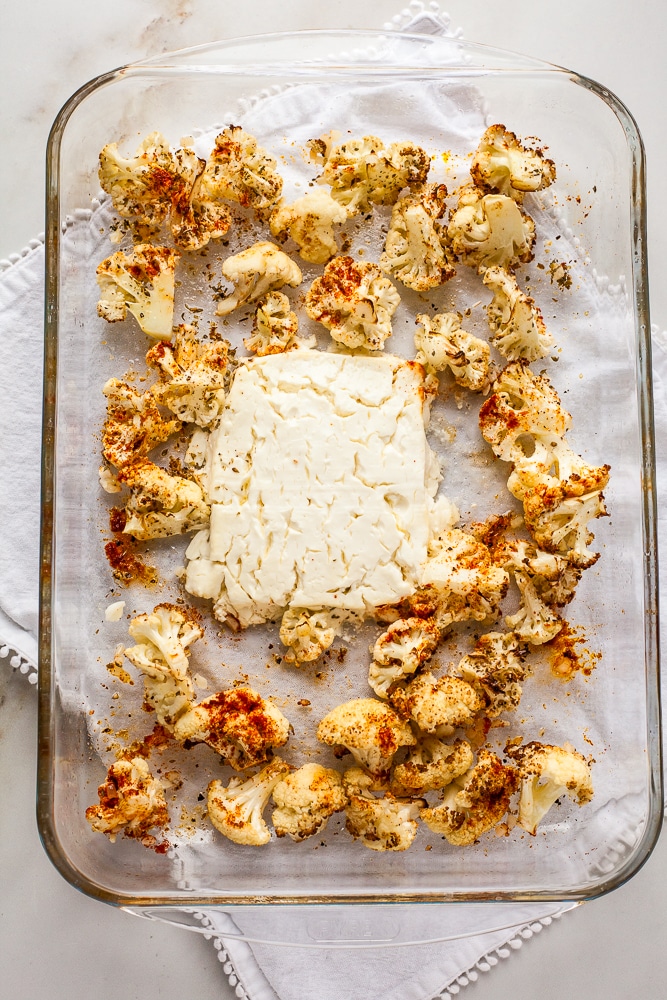
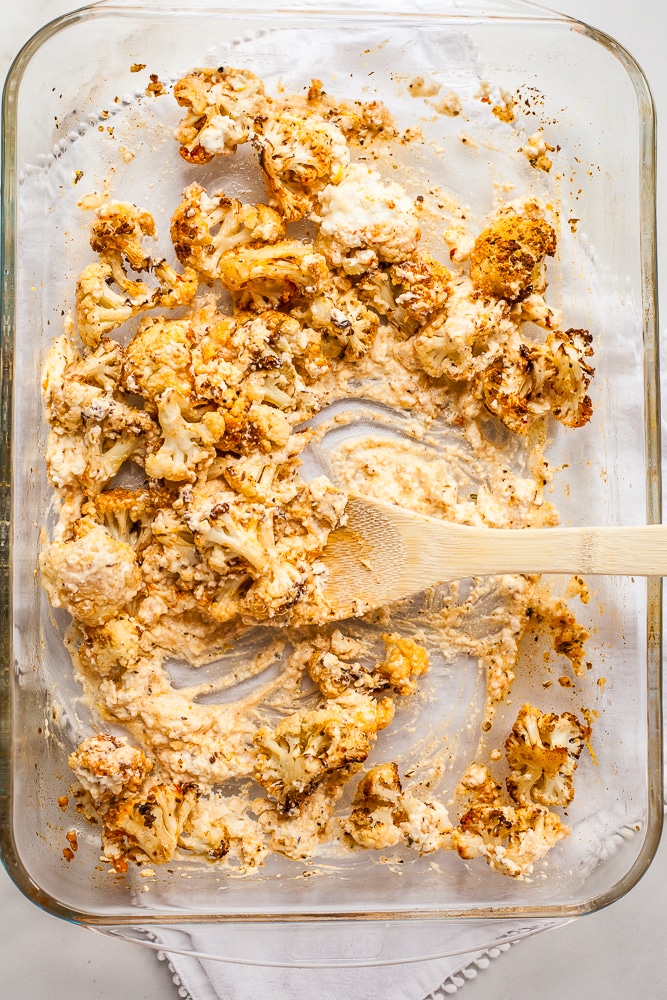
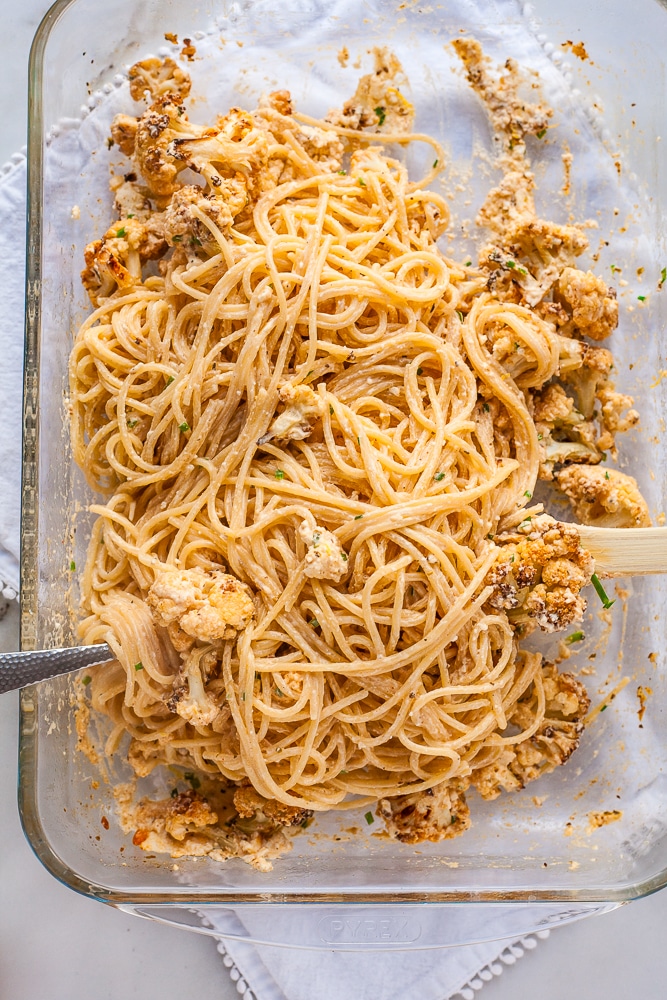
Easy!
Ingredients: What to know
First of all, this recipe can be super cheap if you have access to an Aldi. Nothing needs to be premium here so feel free to go as cheap as you can.
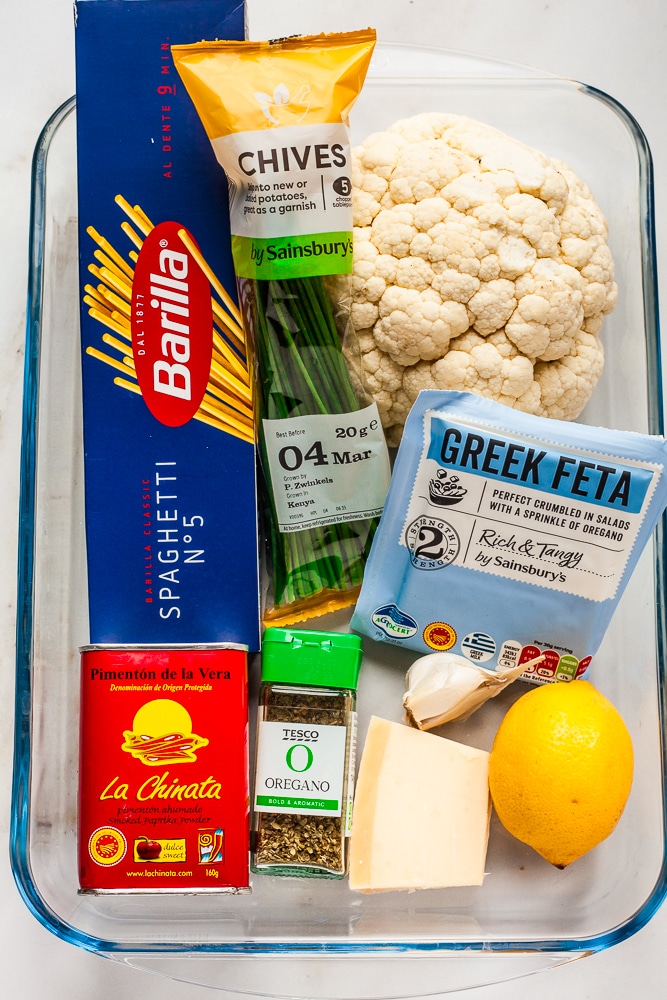
- You don’t have to use spaghetti. Really, any pasta shape will work here. I tried with a few different ones and it’s actually easier to make this with a smaller pasta shape like shells or orecchiette, but there’s something about the long spaghetti strands and the somewhat “meaty” roasted cauliflower that I enjoyed. Spaghetti is also usually the cheapest pasta shape you can buy.
- You need one small cauliflower: You’ll use most or all of the florets from a small head, so if you have a fairly sizeable cauli, you will probably have leftovers.
- Smoked paprika and oregano are my dried spices of choice but there is a lot of potential here. Feel free to use an Italian blend or some thyme, dried parsley, etc. I didn’t always use the smoked paprika in my testing and it’s fine without that too. Just raid your herbs and spices and use something.
- I love fresh chives here, but parsley works too.
- The recipe calls for some parmesan style cheese – whether that be parmesan itself, pecorino or a generic Italian hard cheese. An strong cheddar would work too especially if you’re on a budget. Vegetarians will want to watch out for animal rennet that’s common in Italian cheeses like parmesan.
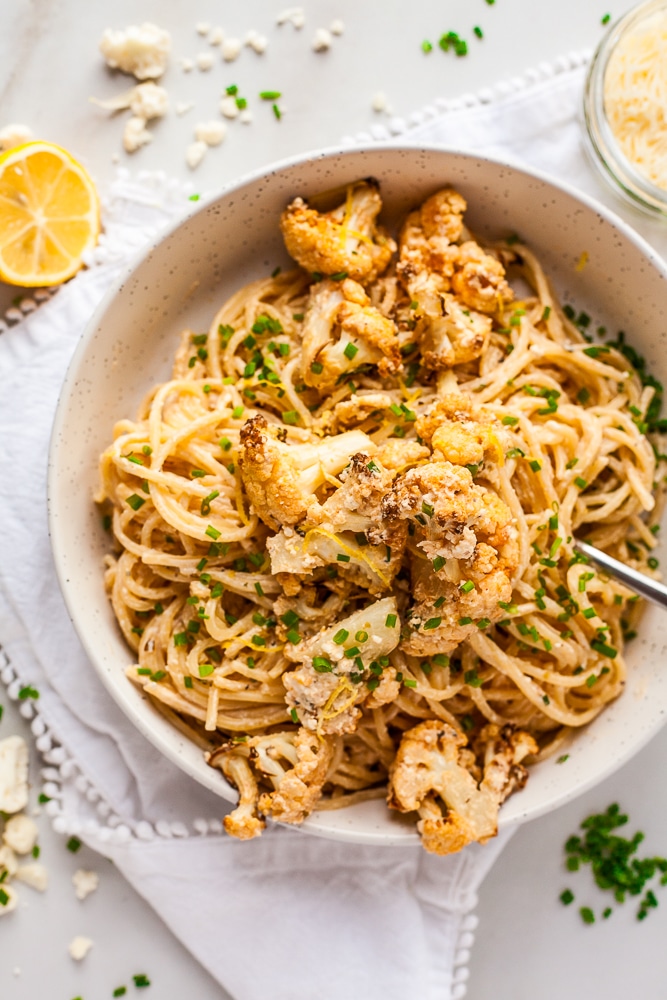
Important: How to get the texture and flavor just right
It’s an easy recipe but it’s not always forgiving – there are a few things you want to pay close attention to for the best result. After testing this recipe 6 times, I made all the mistakes so you don’t have to!
- We add the garlic, smoked paprika, oregano and lemon zest towards the END of the roasting time. This keeps the flavor really bright and stops the garlic burning because realistically the 25-30 minutes the cauliflower needs to roast is too long for garlic and herbs to hold onto their flavor. By timing it right, this dish has huge flavor, more than you’d have expected.
- You want to be generous with the olive oil to keep the cauliflower nice and rich, and help the sauce stay saucy. I was sparse with the oil on the batch photographed, to keep everything looking a little cleaner for the photos, and the cauli wasn’t as decadent as I’d have liked. Don’t be like me – embrace the messy pan and enjoy some oil.
- Once it’s tossed with the pasta, you need to serve it really quickly because it dries out fast. Pasta cooking water is great for giving a velvety smooth creamy texture to your pasta dish, but it soon gets absorbed into the pasta and turns dry (which made for a maddeningly difficult time photographing it). If you feel like this recipe might need to sit for a while, or if the levels of creaminess are really important to you, it’s worth adding a nice pour of heavy (double) cream to the pan when you mix up the cauliflower and feta. This will help its resilience.
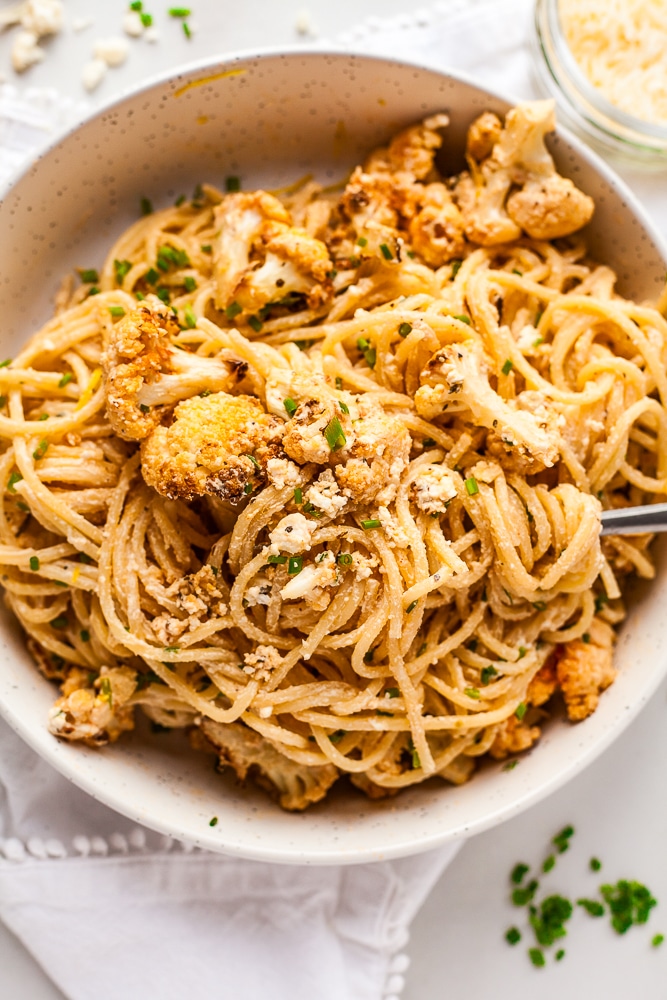
Variations & Other Flavor Combos
- A drizzle of truffle oil added at the same time as the pasta is a lovely addition, especially if you’re not using the smoked paprika.
- Give it a Mediterranean edge with olives, capers, artichokes, sundried tomatoes, etc.
- For crunch, add some toasted pine nuts or buttery toasted breadcrumbs as a topping.
- If you don’t want to use feta, something like soft goat cheese or blue cheese would be great here. But neither of those would hold up to being baked for so long – you would want to add them to the pan later on, alongside the spices, so they just start to melt.
Leftovers?
I find leftovers of this dish dry out a little, but a pour of cream or milk in the container when you reheat it will work wonders. I’d also suggest cutting the cauliflower up a little finer for the leftovers so that it heats more evenly.
More Simple Vegetarian Pasta Recipes
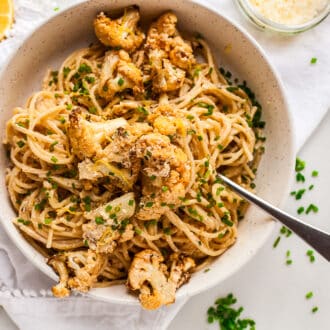
Cauliflower Feta Spaghetti
Ingredients
- olive oil, for roasting
- 9 oz (250 g) spaghetti
- 7 oz (200 g) block of feta cheese
- 1 small head cauliflower florets, or as much as will fit in the pan
- 1 medium lemon, for zesting and juicing
- 3 cloves garlic, chopped
- ½ tsp smoked paprika
- 1 tsp oregano
- salt and pepper, to taste
- ½ cup (50 g) parmesan, pecorino or Italian hard cheese, + more for topping
- 1 small bunch fresh chives, chopped
Instructions
- Preheat the oven to 200C / 400F.
- Assemble the cauliflower and feta. Brush oil along the bottom of your largest baking or roasting dish. Place the block of feta in the middle and arrange cauliflower florets around it. You want the florets in a single layer so don't over-fill the pan. Drizzle with olive oil and salt and pepper to taste, but hold back on the garlic and seasonings for now – they will go in later.Place in the oven.7 oz block of feta cheese, 1 small head cauliflower florets, salt and pepper, olive oil
- After the cauliflower has been baking for 15 minutes, set the pasta boiling according to package instructions.9 oz spaghetti
- Once the pasta is boiling, take the cauliflower out of the oven – it should be getting nicely browned. Add the garlic, oregano and smoked paprika to the cauliflower, mixing through to coat the florets as best you can (but be careful not to disturb the block of feta). Add another drizzle of oil if the pan is drying out.3 cloves garlic, 1/2 tsp smoked paprika, 1 tsp oregano
- Place back in the oven for a further 5-10 minutes. The cauliflower should be well browned and reduced, and the garlic will be fragrant and a little crispy.
- Once you're happy with how the cauliflower is looking, remove from the oven. Add a few grates of lemon zest (1-2 teaspoons worth) and squeeze the juice of the lemon over the top. Add the parmesan cheese and then give it all a good stir – the feta will be melty and creamy and form a sauce around the cauliflower.1 medium lemon, 1/2 cup parmesan, pecorino or Italian hard cheese
- Once the pasta is al dente, drain and reserve some of the cooking water. Add the pasta to the pan with the cauliflower and feta and toss through. Add the chives. As you mix, slowly drizzle in some pasta cooking water to make the sauce a bit looser. I tend to use around 1/2 cup of pasta cooking water, but it needs to be added slowly.1 small bunch fresh chives
- Serve with additional chives and grated cheese on top.

